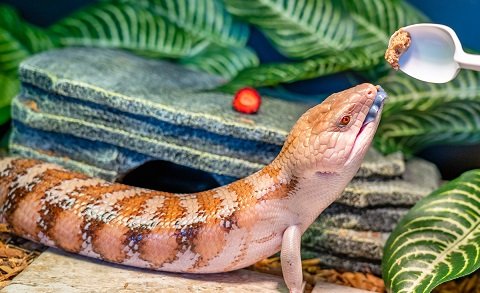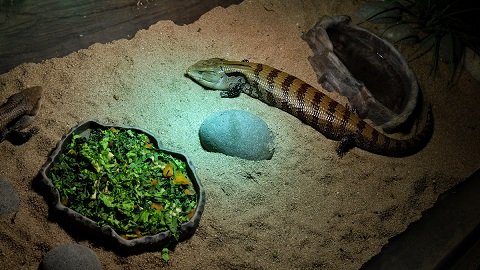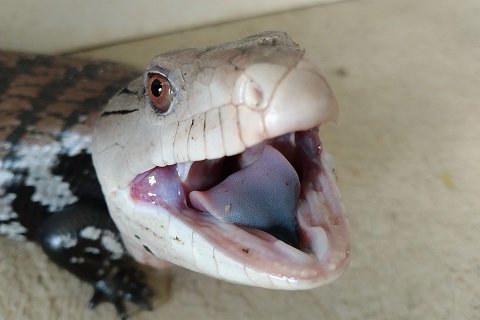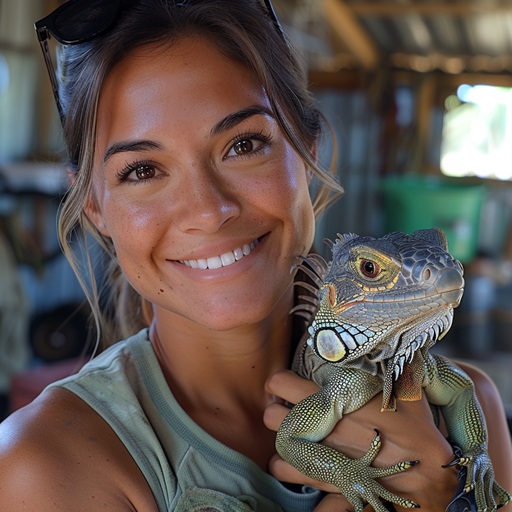Have you ever gazed into the vibrant eyes of a Northern Blue Tongue Skink and wondered what it takes to care for such a unique creature? These fascinating reptiles captivate the hearts of reptile enthusiasts worldwide with their striking appearance and friendly demeanor. As a responsible skink owner, it’s essential to understand the specific care requirements of these extraordinary lizards to help them thrive in captivity. This comprehensive guide will cover everything you need to know about caring for a Northern Blue Tongue Skink, from setting up a proper enclosure to understanding their diet, handling, and breeding.
So, let’s embark on this exciting journey together and discover the mesmerizing world of Northern Blue Tongue Skinks, ensuring their health, happiness, and longevity in your good care.
Skink Basics You Need to Know
- Northern Blue Tongue Skinks require specific care and a suitable enclosure to ensure health and wellness.
- An omnivorous diet of insects, fruits, vegetables, calcium supplements, and multivitamins is essential for proper nutrition.
- Breeding Northern Blue Tongue Skinks can lead to a long lifespan with regular preventative care and monitoring for signs of illness.
Northern Blue Tongue Skink: An Overview
The Northern Blue Tongued Skink (Tiliqua scincoides intermedia) is a diurnal, terrestrial lizard native to the dry forests, grasslands, and shrublands of northern Australia and New Guinea. As one of the blue tongued genus of skinks, the northern blue tongued skink boasts a distinctive bright blue tongue, which serves as a defense mechanism against predators. These captivating reptiles, including the blue tongued skink, can grow up to 13 inches in length and weigh over 450 grams, making them a substantial and impressive presence in any reptile collection.
Caring for a Northern Blue Tongue Skink requires attention to their specific needs, such as a spacious tank with appropriate heating and lighting, as well as a diet that includes feeder insects. By meeting these requirements, you can ensure a healthy and happy life for your skink, allowing them to flourish in your care.

Physical Features
The Northern Blue Tongue Skink is known for its thick, sausage-like body, short but strong limbs, and large, triangular head shape. But the most defining characteristic of this species is their vivid blue tongue, which they display prominently when threatened. This startling display serves as a warning signal to potential enemies, deterring predators and ensuring the skink’s survival in the wild.
In addition to their unique blue tongue, Northern Blue Tongue Skink adults are adorned with an array of colors and patterns, ranging from gray and brown to various shades of orange and yellow. Their scales are typically arranged in bands, providing them with excellent camouflage against potential predators in their natural habitat.

Natural Habitat
The Northern Blue Tongue Skink is native to Australia, New Guinea, and Indonesia, where they inhabit dry forests, grasslands, and shrublands. As terrestrial lizards, they have adapted to a range of environmental conditions and thrive in areas with fluctuating temperatures and humidity levels.
Australian species tend to prefer a lower humidity level of around 40%, while Indonesian subspecies require a higher humidity level of 60-80%. Understanding the specific habitat requirements of your skink is essential for replicating their natural environment in captivity and ensuring their overall health and well-being.
Amazing Physiology of a Skink
| Blue Tongue | The most distinctive feature of a blue-tongued skink is, of course, its bright blue tongue. This is used as a defense mechanism. When threatened, the skink will open its mouth wide and stick out its startlingly blue tongue to scare off predators. |
| Teeth | Blue-tongued skinks have small, cone-shaped teeth. They also have rear teeth that are slightly larger and broader. These are used for crushing the shells of snails and beetles, which are a common part of their diet. |
| Body Structure | Blue-tongued skinks have a heavy, robust body and a large head. They are one of the largest lizards in the Skink family. Their legs are small and may seem out of proportion to the body, but they are quite capable of moving quickly when needed. |
| Scales | They have smooth, overlapping scales that give them a shiny appearance. These scales can vary in color from species to species and can range from shades of blue, grey, brown, and cream. |
| Tail | Their tail is thick and can be used to store fat reserves. In some species, the tail is also prehensile, meaning it can be used to grip objects. |
| Eyes | They have small eyes with vertical pupils, similar to a cat’s eyes. This is an adaptation for their crepuscular lifestyle, as they are most active during dawn and dusk. |
| Ears | Unlike mammals, skinks have ear holes instead of external ears. These ear holes lead directly to their eardrums. |
| Sexual Dimorphism | Males are generally larger than females and have broader heads and larger tails. |
Creating a Suitable Enclosure
A crucial aspect of caring for your Northern Blue Tongue Skink is providing them with a suitable enclosure that mimics their natural habitat. This includes ensuring the appropriate tank size, temperature, and lighting to keep them comfortable and healthy. Since the blue tongued skinks are solitary creatures and territorial by nature, it is not recommended to house more than one skink per enclosure.
In this section, we will guide you through the process of setting up a proper enclosure for your Northern Blue Tongue Skink, covering aspects such as tank size and configuration, temperature gradient and basking area, and lighting requirements.
Tank Size and Configuration

When it comes to housing a Northern Blue Tongue Skink, providing ample space is crucial for their well-being. Adult skinks require a minimum of a 40-gallon tank, although a 55-gallon tank is recommended to ensure they have enough room to explore and thrive. A front-opening enclosure made of glass is most suitable, as it allows for easy access and cleaning.
A well-designed enclosure should include live plants, logs, and rocks, with a larger rock for basking purposes. Providing hiding spots and climbing opportunities is essential, as it allows your skink to escape the heat and feel secure in their environment.
In terms of substrate, a sand/soil mix or woodchip (though, these may be too dry) can be used, with a recommended depth of around 4-6 inches. That said, blue tongue skinks generally prefer a loose and moisture-retaining substrate that allows for burrowing and promotes humidity. Common choices for blue tongue skinks include cypress mulch, coconut coir, organic topsoil, or a mixture of these materials. It is important to ensure that the substrate is safe, free from any harmful chemicals or pesticides, and regularly maintained to maintain cleanliness and prevent any potential health issues for the skink.
Temperature Gradient and Basking Area
Maintaining proper temperatures within the enclosure is vital for the health of your Northern Blue Tongue Skink, as they require a temperature gradient ranging from 70°F to 100°F to regulate their body temperature. To achieve this gradient, a basking area should be set up using a heat lamp, such as a Halogen heat lamp, along with a 100-watt incandescent bulb for the basking spot.
To measure the basking surface temperature, two methods can be used. An infrared thermometer and a digital probe thermometer are both suitable for this purpose. It’s important to periodically check the temperature levels within the enclosure to ensure your skink’s comfort and safety.
Also, be cautious when placing the enclosure near a window, as direct sunlight can cause the temperature to rise up to 110°F, which can be harmful to your skin.

Lighting Requirements
Proper lighting is essential for the overall health of your Northern Blue Tongue Skink, as it aids in the synthesis of essential vitamins and minerals. A 10% UV tube mounted on the top of the cage is recommended, along with a T5 10.0 or 12% bulb for UVB exposure. Be sure to position the UVB bulb on the warm side of the enclosure without any obstruction from mesh, as this can block the UVB rays from reaching your skin.
To replicate the skink’s natural day/night cycle, the basking lamp should be left on for 12 hours daily. This will help regulate their internal clock and promote healthy behaviors, such as basking and feeding.
Feeding and Nutrition
Providing a nutritious and balanced diet is key to the health and longevity of your Northern Blue Tongue Skink. In the wild, these omnivorous reptiles have a varied diet that consists of approximately 50% greens/ plants, 45% insects, and 5% fruit. By offering a diverse range of food items, you can ensure that your skink receives all the essential nutrients they need to thrive.
In this section, we will delve into the specifics of the Northern Blue Tongue Skink’s diet, including their omnivorous nature, the importance of supplements, and tips for maintaining a normal feeding routine.
Omnivorous Diet

As omnivores, Northern Blue Tongue Skinks have a diverse diet that includes insects, fruits, and vegetables. They enjoy a variety of insects, such as brown crickets, black crickets, and locusts, which provide essential proteins and nutrients. In addition to insects, they should be offered a mix of crunchy and leafy vegetables, such as kale, carrots, and collard greens, along with occasional servings of fresh fruit.
It’s crucial to provide a well-rounded diet for your skink, as this helps prevent nutritional deficiencies and ensures their overall health and well-being. Be sure to offer a variety of food items and rotate them regularly to keep your skink interested and engaged during feeding times.
Supplements
In addition to a diverse diet, it’s essential to supplement your Northern Blue Tongue Skink’s meals with calcium and multivitamin powders to ensure proper nutrition. Calcium is crucial for maintaining healthy bones and muscles, while Vitamin D3 helps facilitate the absorption of calcium and other minerals.
By providing these supplements, you can guarantee that your skink receives all the necessary nutrients for a healthy, happy life.
Handling and Interaction

Northern Blue Tongue Skinks are generally friendly reptiles when handled regularly, making them a popular choice among reptile enthusiasts. However, if not handled frequently, they may become timid and apprehensive. To ensure a positive relationship with your skink, it’s essential to understand the proper handling techniques and be aware of their defensive behaviors.
In this section, we will discuss tips for handling and interacting with your Northern Blue Tongue Skink, including building trust, understanding their defensive mechanisms, and maintaining a safe environment for both you and your skink.
Building Trust
Building trust with your Northern Blue Tongue Skink is crucial for creating a strong bond and ensuring their comfort during handling. To acclimate your skink to handling, start by providing them with five minutes of handling per day, gradually increasing the duration as they become more comfortable. Be sure to approach your skink slowly and from behind, as sudden movements can startle them and cause stress.
Offering food items, such as crickets or mealworms, can also help establish trust and create positive associations with handling. By consistently interacting with your skink and slowly introducing them to handling, you can help them become more comfortable and confident in your presence.
Defensive Mechanisms
It’s important to be aware of your Northern Blue Tongue Skink’s defensive behaviors to ensure their safety and comfort during handling. When threatened, these skinks may puff up their body, hiss loudly, and display their bright blue tongue to deter predators. Additionally, they are capable of tail autotomy, a defense mechanism in which they can detach their tail to escape from predators. While the tail will regenerate, it’s vital to support the entire body of your skin during handling to prevent any harm to them.
By understanding your skink’s defensive mechanisms and handling them with care, you can create a safe and comfortable environment for both you and your Northern Blue Tongue Skink.
Health and Wellness

Ensuring the health and wellness of your Northern Blue Tongue Skink is essential for their overall well-being and longevity. By providing a suitable enclosure, maintaining a nutritious diet, and practicing proper handling techniques, you can guarantee that your skink remains healthy and content throughout their lifespan.
In this section, we will discuss important aspects of health and wellness for your skink, including preventative care measures and recognizing signs of illness. By staying vigilant and proactive in your pet’s care, you can help prevent health issues and ensure a long and happy life for your beloved pet.
Preventative Care
Preventative care is a crucial aspect of maintaining the health and well-being of your Northern Blue Tongue Skink. This includes regularly cleaning their enclosure, providing a good diet with an abundance of crunchy and leafy vegetables, and maintaining a moderate humidity level in their environment. Offering a moist hide, such as damp moss or sphagnum moss, can help prevent shedding issues and promote overall skin health.
In addition to these steps, it’s essential to keep an eye out for signs of health issues and consult a veterinarian if any concerns arise. By taking a proactive approach to preventative care, you can ensure that your skink remains healthy and happy for many years to come.
Recognizing Illness
Being able to recognize signs of illness in your Northern Blue Tongue Skink, a reptile known for its short legs, is crucial for their health and well-being. Symptoms of illness may include lethargy, loss of appetite, abnormal behavior, sudden weight loss, respiratory issues, sunken eyes, or bowing of the mandibles. Additionally, improper husbandry, parasites, and stress can contribute to health issues.
If you notice any of these signs in your skin, it’s important to consult a veterinarian for further evaluation and treatment. By staying vigilant and addressing any health concerns promptly, you can help ensure the continued health and happiness of your Northern Blue Tongue Skink.
Breeding and Lifespan

The fascinating world of Northern Blue Tongue Skink breeding is an exciting aspect of reptile ownership. Understanding the mating process, gestation period, and proper offspring care is essential for successfully breeding these captivating lizards. With proper care, Northern Blue Tongue Skinks can live for 10-15 years, making them a long-term commitment for dedicated reptile enthusiasts.
In this section, we will explore the breeding process of Northern Blue Tongue Skinks, including mating, gestation, and offspring care. This information will provide you with the knowledge needed to successfully breed these unique reptiles and ensure a thriving population for future generations.
Mating and Gestation
The mating season for Northern Blue Tongue Skinks occurs from August to the middle of October, with a gestation period of approximately four months. During this time, the female skink will develop and nourish her developing offspring internally, ultimately giving birth to live babies instead of laying eggs. This unique aspect of skink reproduction sets them apart from many other reptiles and contributes to their fascinating biology.
A litter of Northern Blue Tongue Skinks typically consists of between 4 and 6 offspring, although larger litters have been known to occur. By understanding their mating and gestation process, you can better prepare for the arrival of newborn skinks and ensure a successful breeding experience.
Offspring Care
Caring for Northern Blue Tongue Skink offspring requires attention to their specific needs, such as appropriate feeding and housing. Young skinks should be fed daily during their infancy stage, and once or twice a week as they reach adulthood. As for housing, it’s recommended to provide an enclosure of at least 4’L x 2’W x 2’H, with spot cleaning taking place every other day to maintain a clean and healthy environment.
By providing proper care and meeting the specific requirements of your Northern Blue Tongue Skink offspring, you can ensure their healthy growth and development, setting the stage for a thriving future generation of these captivating reptiles.
Consider a Skink for Your Next Pet
Caring for a Northern Blue Tongue Skink can be an incredibly rewarding experience, as these unique reptiles captivate the hearts of reptile enthusiasts worldwide. By providing a suitable enclosure, maintaining a nutritious diet, and practicing proper handling techniques, you can ensure that your skink remains healthy and content throughout their lifespan.
We hope this comprehensive guide has provided you with the knowledge and confidence needed to care for your Northern Blue Tongue Skink. By dedicating time and effort to understand and meet their specific needs, you can create a strong bond with your skink and ensure a long, happy life together.
If you are interested in another reptile pets, you may also see our guides on Iguana and Pet Alligators.
Frequently Asked Questions
How big do northern blue tongue skinks get?
Northern blue tongue skinks are typically 17 to 22 inches in length from snout to tail. They are stocky and robust, with a large head and short legs. They have banded markings and range in color from gray to brown.
What is the behavior of the northern blue tongue skink?
The northern blue tongue skink is a gentle creature that is active during the day, seeking shelter at night. When disturbed, it will extend its blue tongue and puff up its body while hissing loudly as a means of defence. Despite this, the skink remains non-aggressive and tends to run rather than fight.
What do blue tongue skinks eat?
Blue tongue skinks are omnivores and their diet consists of a mixture of plant and animal matter. In the wild, they feed on a variety of insects (even earthworms), snails, flowers, and fleshy leaves. Additionally, they will also scavenge for foods such as carrion and may occasionally hunt small animals, such as mammals, reptiles, birds, and amphibians.
What is the ideal temperature range for a Northern Blue Tongue Skink’s enclosure?
Keeping a Northern Blue Tongue Skink in an environment with temperatures between 70°F and 100°F (21.11°C to 37.78°C) is ideal for their health and wellbeing.
How often should I feed my Northern Blue Tongue Skink?
For optimal health, it is recommended that you feed your Northern Blue Tongue Skink daily when they are young, and then reduce to once or twice a week as they reach adulthood.


